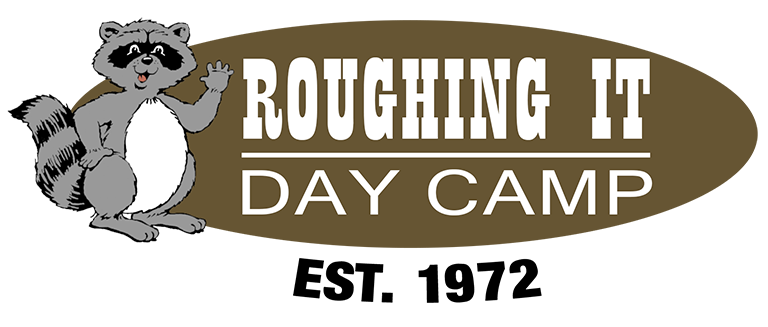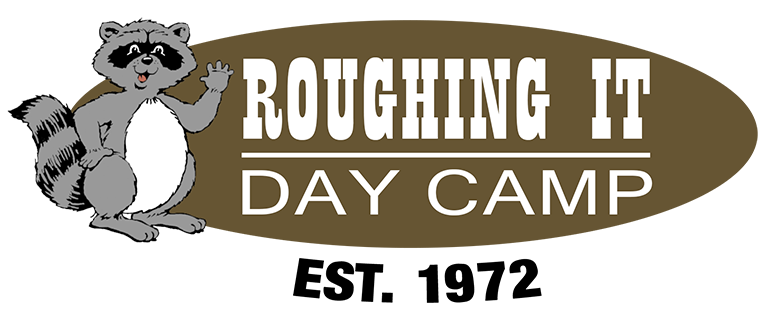Swimming Program - Skill Levels
All campers participate in swim lessons taught by our swim staff (Lifeguard certified) for beginner through advanced levels based on the American Red Cross Swim Program. On the first day of camp, swim staff evaluate all campers and divide them into swim groups based on ability. Below you’ll find details on our Pre-K & Kindergarten – Learn To Swim, Beginner-Advanced Swim Lessons (Levels 1-6), and Teen Swim Clinics.
Pre-K & Kindergarten - Learn to Swim
This Learn to Swim program gives campers ages 4-6 a positive and safe learning experience. Lessons are age-appropriate, designed to teach young campers introductory swim skills with their camper group.
Individualized instruction both one-on-one and in small groups help campers gain confidence and basic swim skills to be water safe. Our instructors utilize a variety of games and water activities to teach basic swim skills and make swimming fun. Our goal is to get campers ready to successfully participate in our swim lesson program for beginners.
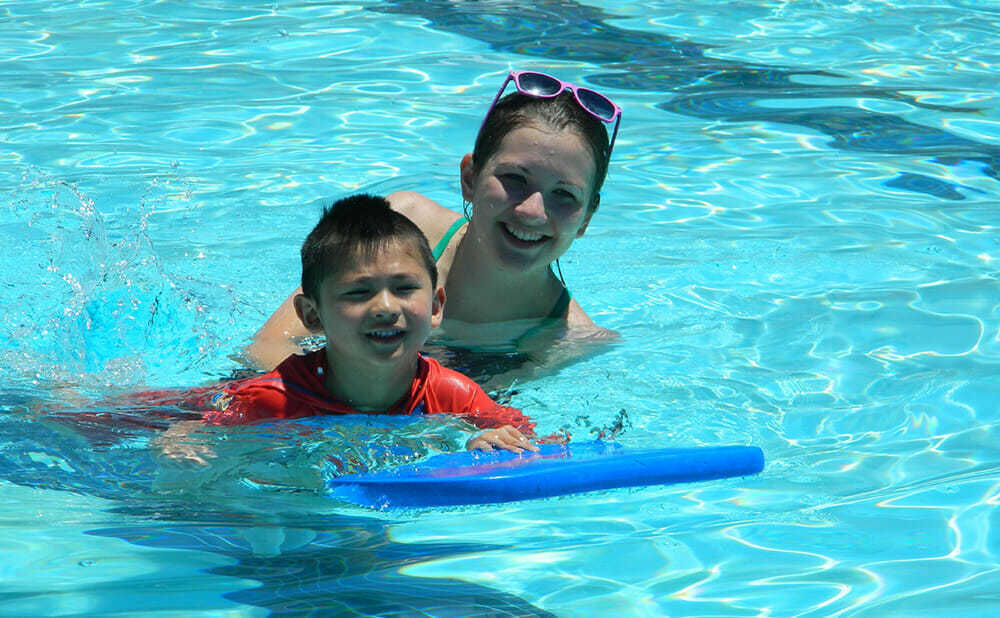
Helps young children feel comfortable in the water and to enjoy the water safely.
- Enter and exit water using ladder, steps or side
- Alternating and simultaneous arm actions on front & back
- Blowing bubbles through mouth and nose
- Combined arm and leg actions on front & back
- Putting face underwater
- Open eyes under water and retrieve underwater objects
- Front glide and recover to a vertical position
- Back float and recover to a vertical position
- Roll from front to back and back to front
- Treading with arm and hand actions
- Alternating and simultaneous leg actions on front & back
Safety Skills
- Staying safe around aquatic environments
- Too much sun is no fun
- How to call for help
- Recognizing an emergency
- Recognizing the lifeguards
NEW!Starfish Award: Campers who successfully complete the following earn the Starfish Award and move onto the next level:
- Entering and Exiting Water: The camper confidently enters and exits the water using the ladder or side of the pool.
- Blowing Bubbles: The camper demonstrates the ability to blow bubbles through their mouth and nose for 3 seconds.
- Putting Face Underwater: The camper puts their face underwater without hesitation when instructed to do so.
- Open Eyes Underwater: The camper opens their eyes underwater.
Builds on skills learned in Level 1 and gives younger children success with fundamental skills such as floating and basic locomotion.
- Enter water by stepping in
- Combined arm and leg actions on front and back
- Exit water using ladder or side
- Bobbing
- Open eyes under water and retrieve underwater objects
- Front and back floats and glides
- Recover from a front and back float or glide to a vertical position
- Roll from front to back and back to front
- Tread water using arm and leg actions
Safety Skills
- Too much sun is no fun
- Staying safe around aquatic environments
- Recognizing the lifeguards
- Recognizing an emergency
- How to call for help
NEW!Super SeaStar Award: Campers who successfully complete the following earn the Super SeaStar Award and move onto the next level:
- Combined Arm and Leg movement on Front and Back: The camper swims using combined arm and leg movements on both the front and back.
- Bobbing: The camper demonstrates bobbing, putting their entire body under the water and resurfacing.
- Retrieve Underwater Objects: The camper opens their eyes underwater and retrieves an object from the pool floor.
- Recovering to Vertical Position: The camper recovers from a front or back float or glide to a vertical position with some assistance.
- Rolling: The camper demonstrates the ability to roll from front to back and back to front.
Builds on the skills in Level 2 and improves younger children’s coordination of simultaneous arm and leg actions and alternating arm and leg actions.
- Enter water by jumping in
- Putting face underwater
- Bobbing
- Front, jellyfish and tuck floats
- Back float and glide
- Recover from a front and back float or glide to a vertical position
- Change direction of travel while swimming on front or back
- Tread water using arm and leg actions
- Combined arm and leg actions on front and back
Safety Skills
- Think so you don’t sink
- Look before you leap
- Staying safe around aquatic environments
- Recognizing an emergency
- Too much sun is no fun
- How to call for help
NEW!Jellyfish Award: Campers who successfully complete the following earn the Jellyfish Award and move onto the next level:
- Entering Water by Jumping In: The camper enters the water by jumping in from the poolside, demonstrating confidence.
- Front Floats: The camper demonstrates front floats while remaining calm and stable.
- Back Float: The camper performs a back float showing comfort in this position.
- Change Direction of Travel: The camper is able to change direction while swimming on their front or back, showing control over their movement.
- Treading Water: The camper successfully treads water using arm and leg movements for at least 15 seconds.
- Combined Arm and Leg Movements on Front and Back: The camper demonstrates the ability to swim using combined arm and leg actions on both their front and back for at least two body lengths.
Beginner-Advanced Swim Lessons (Skill Levels 1-6)
For campers 1st-6th grades, we teach beginner through advanced swim lessons based on the American Red Cross swim program. This is a comprehensive, developmentally appropriate swimming and water safety program that teaches your child how to both swim skillfully and safely, and think and act safely in, on and around the water. Based on a six-level progression, it allows campers to practice and master the basics before moving on to more advanced skills. Instructors use a variety of games and water activities to make learning fun and a positive experience.
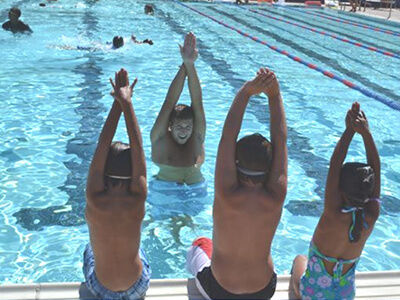
Campers need no prior skills or swim experience. Individualized instruction both one-on-one and in small groups help campers to gain confidence and basic swim skills to be water safe. Campers are encouraged to learn at their own pace in order to become comfortable in the water.
Skills:
- Enter water using ladder or side
- Exit water using ladder or side
- Blowing bubbles through mouth and nose, 3 seconds
- Bobbing, 3 times
- Front glide, 2 body lengths
- Back glide, 2 body lengths
- Back float, 3 seconds
- Roll from front to back
- Roll from back to front
- Treading using arm and hand actions (in chest-deep water)
- Kicking on the wall, front and back
- Combined arm and leg actions on front, with assistance
- Combined arm and leg actions on back, with assistance
Safety Skills:
- Staying safe around aquatic environments
- Recognizing the lifeguards
- How to call for help
NEW!Clownfish Award: Campers who successfully complete the following earn the Clownfish Award and move onto the next level:
- Putting Head Underwater: The camper confidently enters the pool and fully immerses their head underwater without hesitation when instructed to do so.
- Floating with Assistance: The camper demonstrates the ability to float on their front and back with assistance from a counselor, maintaining the float for at least 3 seconds.
- Combined Arms and Legs: With assistance from a counselor, the camper propels themselves forward using combined arm and leg movements, covering a distance of at least two body lengths.
- Wall Kicking: The camper holds onto the wall and confidently performs flutter kicks on both their front and back.
Gives campers success with fundamental swim skills.
Skills:
- Enter water by stepping or jumping from the side (in shoulder-deep water)
- Exit water using ladder, steps or side (in chest-deep water)
- Putting face underwater and holding breath, 5 seconds
- Swim under water, 3-5 body lengths
- Bobbing, 5 times (in chest-deep water)
- Front float, 5 seconds
- Jellyfish float, 5 seconds
- Front glide, 2 body lengths
- Back float, 15 seconds
- Back glide, 2 body lengths
- Roll from front to back
- Roll from back to front
- Change direction of travel while swimming on front or back
- Treading using arm and leg actions, 15 seconds (in shoulder-deep water)
- Combined arm and leg actions on front, 5 body lengths, independently
- Combined arm and leg actions on back, 5 body lengths, independently
Safety Skills:
- Staying safe around aquatic environments
- Recognizing an emergency & lifeguards
- How to call for help
- Look Before You Leap
NEW!Seal Award: Campers who successfully complete the following earn the Seal Award and move onto the next level:
- Front Glide: The camper confidently performs a front glide from the wall, traveling a distance of at least 2 body lengths.
- Back Glide: The camper performs a back glide, maintaining a face-up position while gliding for at least 2 body lengths.
- Underwater Swim: The camper swims underwater for a distance of 3 to 5 body lengths with strong breath control.
- Treading Water: The camper demonstrates the ability to tread water independently for 15 seconds.
- Combined Arm and Leg Action: The camper swims a distance of 5 body lengths, coordinating arms and legs without assistance.
Builds on the skills in Level 2 through additional guided practice in deeper waters.
Skills:
- Enter water by jumping from the side (into deep water)
- Headfirst entry from the side in a sitting position (in water at least 9 feet deep)
- Headfirst entry from the side in a kneeling position (in water at least 9 feet deep)
- Side breathing, 10 times
- Independent back float, 30 seconds
- Tread water, 30 seconds (in deep water)
- Streamlined flutter kick, 3-5 body lengths
- Streamlined dolphin kick, 3-5 body lengths
- Freestyle, 15 yards
- Elementary backstroke, 15 yards
- Scissors kick, 10 yards
Safety Skills:
- Staying safe around aquatic environments
- Recognizing an emergency & lifeguards
- How to call for help
- Look Before You Leap
NEW!Butterfly Fish Award: Campers who successfully complete the following earn the Butterfly Fish Award and move onto the next level:
- Back Float: The camper independently maintains a back float for 30 seconds, demonstrating confidence and balance.
- Backstroke: The camper swims backstroke for a continuous distance of 15 yards, maintaining proper rhythm and body position.
- Freestyle with Side Breathing: The camper performs freestyle for 15 yards, demonstrating consistent side breathing at least 10 strokes.
- Streamlined Dolphin Kick: The camper performs a streamlined dolphin kick for a distance of 3 to 5 body lengths.
Develops confidence in the skills learned and improves other aquatic skills.
Skills:
- Headfirst entry from the side in a compact position (in water at least 9 feet deep)
- Headfirst entry from the side in a stride position (in water at least 9 feet deep)
- Feet first surface dive, submerging completely
- Survival swimming, 30 seconds (in deep water)
- Freestyle open turn
- Backstroke open turn
- Tread water using 2 different kicks (modified scissors, modified breaststroke or rotary), 2 minutes
- Freestyle, 25 yards
- Breaststroke, 15 yards
- Butterfly, 15 yards
- Backstroke, 15 yards
- Push off in a streamlined position on back and begin flutter kicking, 3-5 body lengths
- Push off in a streamlined position on back and begin dolphin kicking, 3-5 body lengths
Safety Skills:
- Staying safe around aquatic environments
- Recognizing an emergency & lifeguards
- How to call for help
- Look Before You Leap
- Reach or Throw, Don’t Go (reaching assist, throwing assist)
NEW!Yellow Tang Award: Campers who successfully complete the following earn the Yellow Tang Award and move onto the next level:
- Freestyle: The camper swims freestyle for a continuous distance of 25 yards, showcasing strong arm strokes and consistent breathing.
- Backstroke: The camper completes a 15-yard backstroke with proper technique and rhythm.
- Butterfly: The camper swims butterfly for 15 yards, demonstrating coordination between arms, legs, and breathing.
- Breaststroke: The camper performs breaststroke for 15 yards with proper timing, glide, and kick technique.
- Freestyle with Open Turn: The camper completes freestyle for 25 yards, incorporating an open turn at the wall.
Provides further coordination and refinement of strokes.
Skills:
- Tuck surface dive, completely underwater
- Pike surface dive, completely underwater
- Front flip turn while swimming
- Backstroke flip turn while swimming
- Tread water, 5 minutes
- Freestyle, 50 yards
- Breaststroke, 25 yards
- Butterfly, 25 yards
- Backstroke, 25 yards
- Standard scull, 30 seconds
Safety Skills:
- Staying safe around aquatic environments
- Recognizing an emergency & lifeguards
- How to call for help
- Look Before You Leap
- Reach or Throw, Don’t Go (reaching assist, throwing assist)
NEW!Barracuda Award: Campers who successfully complete the following earn the Barracuda Award and move onto the next level:
- Freestyle: The camper swims freestyle for a distance of 50 yards, demonstrating closed turns, strong arm strokes, and consistent breathing.
- Backstroke Flip Turn: The camper performs a backstroke flip turn, transitioning smoothly and maintaining proper rhythm.
- Breaststroke: The camper completes a 25-yard breaststroke with proper timing, glide, and kick technique.
- Butterfly: The camper swims butterfly for 25 yards, coordinating arms, legs, and breathing effectively.
Refines the strokes so participants swim them with ease, efficiency, power and smoothness over greater distances. Level 6 is designed with options that focus on preparing campers for a lifetime of fitness & safety.
Skills:
- Freestyle, 100 yards
- Backstroke, 100 yards
- Breaststroke, 50 yards
- Butterfly, 50 yards
- Freestyle flip turn while swimming
- Backstroke flip turn while swimming
- Butterfly turn while swimming
- Breaststroke turn while swimming
NEW!Sunfish Award: Campers who successfully complete the following earn the Sunfish Award:
- Freestyle: The camper swims freestyle for 100 yards, demonstrating strong technique, consistent side breathing, and effective closed turns.
- Backstroke: The camper completes a 100-yard backstroke, incorporating closed turns and awareness of the stroke count from the flags to the wall.
- Breaststroke: The camper performs breaststroke for 50 yards, maintaining proper timing, glide, kick, and turn technique.
- Butterfly: The camper swims butterfly for 50 yards, showing coordination between arms, legs, breathing, and proper turn technique.
Skills:
- HELP position, 2 minutes (in deep water)
- Huddle position, 2 minutes (in deep water)
- Feet first surface dive (in water at least 7-feet deep)
- Tuck surface dive (in water at least 7-deep)
- Pike surface dive (in water at least 7-feet deep)
- Back float, 5 minutes (in deep water)
- Survival float, 5 minutes (in deep water)
- Survival swimming, 10 minutes
- Treading water, kicking only, 2 minutes (in deep water)
- Surface dive and retrieve an object from the bottom (in water at least 7-10 feet deep)
Safety Topics:
- Staying safe around aquatic environments
- Recognizing an emergency & lifeguards
- How to call for help
- Look Before You Leap
- Reach or Throw, Don’t Go (reaching assist, throwing assist)
Skills:
- Body alignment and control
- Surface Dive
- Dive from kneeling position from poolside/ diving board
- Standing dive from poolside
- Forward dive fall-in from diving board
- Standing dive from diving board
- One-part/Two-part takeoff on deck
- One-part takeoff from poolside
- One-part/Two-part takeoff from diving board
- Tuck position
- Pike position
- Forward jump, pike position with one-part/two-part takeoff from diving board
- Forward dive, pike position with one-part/two-part takeoff from diving board
Teen Swim Clinics
Campers 7th-10th grades participate in clinics for novice through advanced swimmers. They select 1-2 swim activities to specialize in each session, including water polo, diving, synchronized swimming, water rescue, stroke techniques, endurance building, and more. Each clinic incorporates swim fitness, endurance building and stroke techniques.
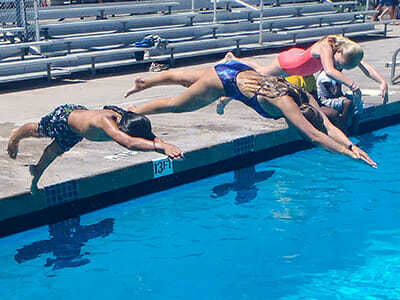
- Freestyle, 100 yards
- Backstroke, 100 yards
- Breaststroke, 50 yards
- Butterfly, 50 yards
- Freestyle open turn while swimming
- Backstroke open turn while swimming
- Front flip turn while swimming
- Backstroke flip turn while swimming
- Butterfly turn while swimming
- Breaststroke turn while swimming
Diving – Springboard
- Basic diving techniques and positioning
- Swan dive
- Tuck dive
- Racing dive
- Pike Dive
Diving – High Dive
- Pencil dive
- Swan dive
- Racing dive
- Egg beater kick
- Heads-up freestyle
- Shooting
- Passing
- Teamwork
- Ball Control
- Sportsmanship
- Freestyle
- Backstroke
- Breaststroke
- Butterfly
- Flip Turns
- Starts and Finishes
- Swim Alcatraz (complete 1 mile swim)
- Ballet legs
- Tugboat
- Sculling
- Pinwheel
- Split leg
- Routine
- Stroke improvement
- Egg beater kick
- Oyster
- Dolphin
- Crane
NEW!Junior Lifeguard I
- Stride jump entry
- Feet first jump entry
- Position for a rescue/tow
- Rescue tube positioning
- Wrist tow
- Shallow water assist removal from water
- HELP position, 2 minutes (in deep water)
- Huddle position, 2 minutes (in deep water)
- Feet first surface dive to recover a submerged victim
- Treading water, kicking only, 2 minutes (in deep water)
- Surface dive and retrieve an object from the bottom (in water at least 7-10 feet deep)
- Backboard spinal injury (in shallow water)
NEW!Junior Lifeguard II
- Underwater swimming to recover a submerged victim
- Recovery of a submerged victim
- Back float, 5 minutes (in deep water)
- Survival float, 5 minutes (in deep water)
- Survival swimming, 10 minutes
- Feet first surface dive (in water at least 7-feet deep)
- Tuck surface dive (in water at least 7-feet deep)
- Pike surface dive (in water at least 7-feet deep)
- Backboard spinal injury (in deep water)
